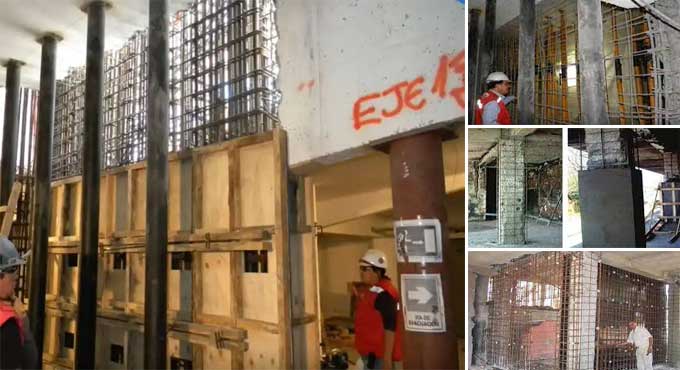
What is the best way to fix concrete members that have been damaged in structures?
Demolition and removal of existing structural elements are required for the replacement of damaged concrete elements. In order to demolish the structural member, proper jacking must be applied to relieve the imposed loads.
Existing steel bars should be treated with great care to avoid damage. Splicing existing bars with newer ones is considered this measure.
In the case of severely damaged structural members, it is considered to replace the structural member completely, since it would be the most cost-effective method or the most economical choice as far as the repair of the structural member is concerned. As a result of earthquakes, the replacement method has been widely used as a method to repair damaged structures.
Ideally, the newly constructed structural element should have strength comparable to that of its predecessor or at least be able to improve to some degree over the previous element. It is possible to replace all damaged concrete structural members, including beams, columns, braces, and walls.
What are the circumstances in which damaged concrete members need to be replaced?
When all other strengthening techniques fail, this method can be used. There is a variety of applications for this technique, including the repair of deteriorated buildings, as well as the increase of the life span of various structures, particularly bridges.
The use of this method can be particularly useful when it comes to strengthening buildings that have been damaged by earthquakes.
What are the specifications of Repair Materials?
Specifying the materials for repairing a building should be done in accordance with the specifications and recommendations of the applicable code.
When it comes to reinforced masonry walls, for instance, it is recommended that open ended masonry units be employed, and the masonry units, grouts, and mortar used need to meet the requirements of the ACI530/ASCE 6 specification. It is recommended that the concrete itself has a minimum strength of 21 MPa in order to be used as a reinforced concrete member.
Execution for the replacement
- Whenever the damaged structural member is a load-bearing member, it is necessary to provide shoring adjacent to it in order to resist loads while the member is being demolished and not performing the function of carrying loads.
- There are various ways in which the surface of the surrounding structure can be prepared in order to ensure adequate bonding between the existing structure and the new one, such as roughening the surface.
- It is important to use the appropriate tools such as saws and chipping tools to carefully demolish the structural member.
- The reinforcing bars should be anchored into holes with epoxy in the existing structure if they are required to be attached to the existing structure in order to prevent them from moving.
- It is necessary to splice the new reinforcing bars into the existing ones.
- In order to ensure that the steel bars are used to their full potential, the hole depth needs to be sufficient in order for the bars to be able to reach their maximum potential. In order to find out the proper depth of the epoxy bar and for instructions regarding how to install the epoxy, it is recommended that you consult with the epoxy manufacturer.
- In order to pour the new concrete, it is necessary to use suitable methods.
- A hole in the formwork allows fresh concrete to be poured, and additional holes may be needed to provide access for vibrators to consolidate the concrete.
- For concrete to achieve its intended strength, it needs to be properly cured.
Considerations for Practice
Considering that the newly placed concrete is inevitably going to shrink and the existing concrete is not going to move, as a result, the newly constructed member is going to develop cracks due to shrinkage.
If there has been a significant amount of shrinkage of the materials, such as after two to four months, then these cracks need to be repaired. In order to repair shrinkage cracks, epoxy or any other material that is suitable for the purpose should be used.
The resin-anchored dowels should be load-tested to a minimum of 50% of the yield strength of the bar for a percentage of the dowels to be load-tested. In order to ensure that epoxy is installed correctly, a special inspector familiar with epoxy installation should observe the process.
Before forming the concrete, it is imperative that the layout and anchorage of the reinforcing steel are checked before it is placed.
To get more details, watch the following video tutorial.
Video Source: NPTEL-NOC IITM


